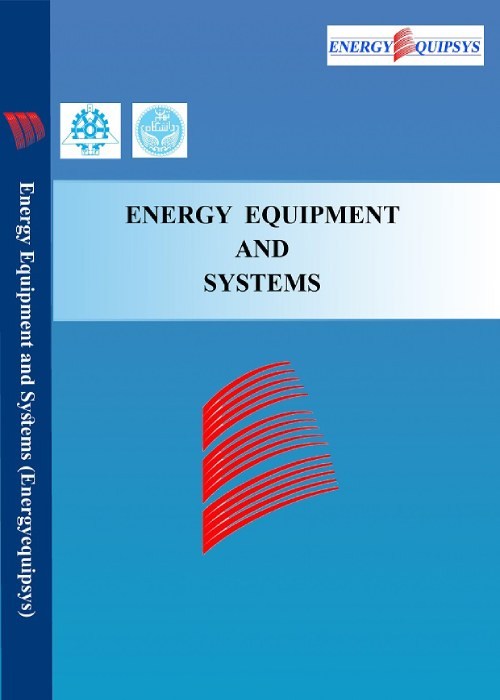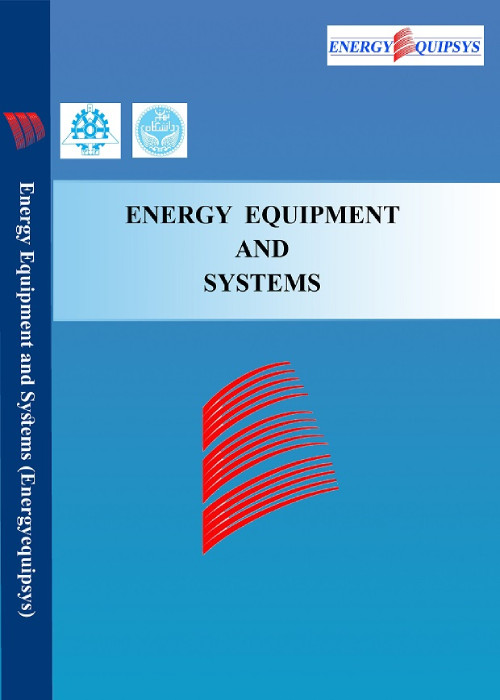فهرست مطالب

Energy Equipment and Systems
Volume:11 Issue: 1, Winter 2023
- تاریخ انتشار: 1402/03/16
- تعداد عناوین: 7
-
-
Pages 1-11Daylight is one of the most influential parameters of visual quality, especially in spaces like art exhibitions. Skylights are proper choices to provide daylight, improve visual comfort, and reduce artificial lighting energy consumption. In this paper, the effect of the main design parameters of skylights on the visual quality is studied using DesignBuilder software. An 81 m2 exhibition area is assessed as a test case. The design variables are the skylight form, orientation, location, glazing type, and splay angle. Also, luminance uniformity, spatial daylight autonomy (sDA), and useful daylight illuminance (UDI) are used as evaluation metrics. The north-oriented curved skylight leads to the best visual quality among the studied cases based on the results. Installing the skylight on the north side of the exhibition roof is better to provide the best luminance uniformity. Besides, the results showed that triple Low-E glazing provides the most uniform and the least maximum luminance. However, it may slightly reduce sDA. Finally, although the effect of splay angle on the visual comfort indexes depends on the intended time, 45° to 60° angles work satisfactorily.Keywords: Daylighting, Skylight, visual comfort, Spatial Daylight Autonomy (sDA), Useful Daylight Illuminance (UDI)
-
Pages 13-28
Solar air heaters are the simplest heat exchangers for converting solar irradiation into air enthalpy, but their efficiencies are low because the low density and heat capacity of the working fluid. To improve the performance, a new configuration of jet technique is proposed for heat transfer augmentation. The air jet streaks the heated absorber, which leads to extra turbulence and more rate of convection heat transfer. This technique is examined numerically here for the first time in a two-glazed double pass solar air heater by the Computational fluid dynamics simulation using the COMSOL Multiphysics. The hydrodynamic and thermal behavior of the heater is obtained by numerical solution of the continuity, momentum, and energy equations for both forced and free convection turbulent air flow based on the k–ε turbulence model. Also, the Laplace equation is solved for obtaining the temperature fields in solid elements. The performance of the proposed solar heater is investigated under different incoming solar heat flux and air mass flow rates. A significant increase in thermal efficiency for double pass solar air heaters with jet impinging technique is seen in comparison to conventional solar collectors. The maximum percentages of efficiency increase for the studied test cases are 10% and 6%, corresponding to 0.02 kg/s and 0.04 kg/s air mass flow rates, respectively.
Keywords: Jet Impingement, Double Pass SAH, Performance, Turbulent flow -
Pages 29-42Electrochemical impedance spectroscopy is a powerful tool for determining the behavior of electrochemical systems. Despite being costly and time-consuming, the time-domain impedance calculation of electrochemical systems is advantageous. However, this method exhibits a high error rate under noise conditions. In this study, the linear technique is developed to minimize noise effects when calculating the impedance of electrochemical systems in the time domain. Multiple equivalent circuit samples are simulated, and the linear technique versus the standard fast Fourier transform method for a noisy input is compared. The results indicate that its error rate is considerably less than that of the fast Fourier transform. The error rate in the Li-ion battery equivalent circuit was reduced from 273.5446 using the fast Fourier transform to 0.0049 using the linear method. Notably, this reduction is significant and on the order of . Additionally, the decline in the real and imaginary parts of mean relative error is in the order of 10. It is concluded that the linear method results in less error in the presence of noise and is faster than traditional electrochemical impedance spectroscopy in the frequency domain. Thus, the linear method outperforms the fast Fourier transform method in time-domain electrochemical impedance spectroscopy.Keywords: Impedance, Electrochemical Systems, Time Domain, Noise, Linear Method
-
Pages 43-53In the present study, the transient vibration of a fixed cylinder attached to an elastic piezoelectric splitter plate is examined. The vibration frequency of these systems is a combination of vortex shedding frequency and splitter plate natural frequency. Therefore, Geometric plate and fluid flow parameters that affect the structure’s frequency and dynamic behavior are investigated. The fluid-solid interaction model is developed for the described problem to determine the splitter motion patterns and their effect on the vortex shedding frequency and the estimated piezoelectric output power. The effect of involving parameters such as inlet fluid velocity, density ratio, splitter plate length and stiffness on the dynamic response of the device and the produced power is inspected. A comparison between the data of the present study and those reported in the literature is conducted and great agreement is achieved. Results show that the decreasing of dimensionless Young modulus of plate or increasing dimensionless plate length and density ratio decreases the natural frequency of the system. By increasing the fluid velocity from 1 to 4, 8 and 16, respectively the excitation modes of 1st, 1st and 2nd, first three and first four are activated and higher plate deflections are obtained.Keywords: Vortex-Induced Vibration, Piezoelectric Flexible Splitter Plate, Fluid-solid interaction, CFD
-
Pages 55-68This study presents a novel approach to fabricating a low-cost solar parabolic dish concentrator with one-meter-long glass/silver mirrors on the reflecting surface. The concentrator's parabola curve is made of four layers of fiberglass needle felt and polyester resin. The parabolic dish surface is mirrored vertically with 2 mm thickness glass/silver mirrors with a width of 5 cm and a length of one meter attached with silicone glue. The system is assembled and tested at the Sharif University of Technology in Tehran, Iran. Energy and exergy efficiencies are calculated using cylindrical water heater receiver data. These data are used to calculate the receiver’s absorbed energy and losses. Test results show that the major energy loss is due to convection. The average energy efficiency and the maximum exergy efficiency of the concentrator are 57% and 67%, respectively. The maximum power absorbed by the water is 1656.8 W at midday, and the maximum temperature observed on the receiver is 540 ̊C. Finally, a discussion is held to propose ideas to improve the fabrication process of the designed parabolic dish concentrator. This type of fabrication is suitable for regular thermal applications. However, several deficiencies are detected, and a few solutions are suggested. Mirror edges and flexibility are two of the parabolic dish's major defects.Keywords: Solar Energy, Parabolic Dish Fabrication, Solar Concentrator, receiver, Efficiency
-
Pages 69-94In this review article, the thermal performance of dual-tube heat exchangers with smooth walls is investigated in the presence of nanofluids. Important challenges in industrial and engineering processes, such as the failure of thermal devices to respond to higher capacities, conservation, saving, and optimization of energy, have been discussed in recent years. Heat exchangers are one of the types of thermal devices that are used in a wide range of engineering and industrial applications. The use of nanofluids is one of the most effective ways to enhance the thermal conductivity of heat exchangers in the industry. In this research, the types of heat exchangers are first introduced. Then, the methods of heat transfer enhancement (active, passive, and combined) are discussed. The introduction and method of preparing nanofluids are discussed, and finally, the studies on dual-tube heat exchangers in the presence of nanofluids are described. This review article examines previous studies on dual-tube heat exchangers and the use of nanofluids in them (216 references and 73 journals). The purpose of this article is to familiarize the readers with the types of heat exchangers and to understand the mechanisms of heat transfer in the context of using nanofluids in smooth dual-tube heat exchangers. It can be concluded that nanofluids are a very good substitute for other fluids because the use of nanofluids in heat exchangers leads to an improvement in their performance, a reduction in their energy consumption and costs, a decrease in their volume, a reduction in environmental effects, etc. Eventually, the challenges in the use of nanofluids in flat dual-tube heat exchangers are discussed. The most important ones include the economic costs of using nanofluids, deposition and accumulation of nanoparticles over time, stability of nanofluids, and lack of standardization among various researches and evaluations.Keywords: heat exchanger, Dual-Pipe, nanofluid, Heat Transfer, Thermal Performance
-
Pages 95-122In recent decades, the environmental concerns about utilization of fossil fuels in energy systems have convinced the researchers to chase and employ the carbon-free fuels. Ammonia, regardless of its higher combustion temperature and the significant NOx emission is considered as a promising type of carbon-free fuels, which improving its chemical properties would introduce it as an excellent heat source of power plants. In present study, the proposal of series of ammonia and methane/hydrogen Brayton cycles connected through the exhaust gas recirculation (EGR) unit was investigated. The EGR unit allowed the overall combined cycle to run with the least value of carbon dioxide and NOx. Hence, the chemical and thermodynamic analyses were carried out to yield the optimum molar fractions of fuel mixture, which resulted in lower combustion temperature, higher thermal efficiency as well as specific work. Focusing on the equivalence ratio () as the key parameter in this study, the results showed that under operating conditions, the overall thermal efficiency improved from 63% to 74%, while the remarkable efficiency improvements in all the three subordinate cycles was observed. In addition, the specific work of overall system showed 80% improvement by 1000 kJ/kg. Furthermore, injection the hydrogen to methane combustion could illuminate the carbon dioxide near to zero. Besides, finding the optimum molar fractions of ammonia-air mixture under the rich region diminished the NOx emission from about 1000 ppm down to 10 ppm in . This index in lean region was decreased from 2500 ppm to 1200 ppm.Keywords: Integration, EGR, Equivalence ratio, NOx Emission


